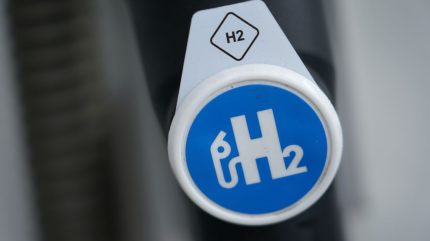
In 1987, a crew sent to drill water wells in the village of Bourakébougou, Mali, came across something unexpected. After drilling 108m at one site, with no water to be found, one of the crew lit a cigarette – and a blast of fire blew into his face (he survived, but was burnt).
The crew had not found water but hydrogen, the lightest molecule in the universe. Soon, villagers were able to put the discovery to use, bringing in a Ford generator, which they ran on the naturally occurring fuel to finally bring electricity to the village. To this day, hydrogen is used to power shops and homes in Bourakébougou, producing only water vapour when burnt.
As geologists have furthered their understanding of the Earth’s crust and its contents, it is now clear that what was discovered is far from unique. The US Geological Survey estimates there are five trillion tonnes of hydrogen reserves worldwide. Humans consumed around 105 million tonnes of hydrogen in 2023. If only 2% of the estimated hydrogen reserves are accessible to humans, they could meet current demand for the next 1,000 years.
“Natural hydrogen is produced by water splitting naturally through chemical reactions with common rocks,” explains Chris Ballentine, head of the Department of Earth Sciences at the University of Oxford. “It is produced by the Earth in vast quantities. The challenge is capturing that hydrogen and being able to use it productively.”
A vast amount of capital continues to be invested in 'blue' hydrogen made from natural gas with carbon capture and storage (CCS), as well as 'green' hydrogen produced by electrolysing water with renewable energy. Harnessing natural hydrogen, however, could be significantly cheaper.
"All the hydrogen used today is manufactured,” explains Jon Gluyas, director of the Energy Institute at the University of Durham, UK. "The problem with manufacturing hydrogen is you have got to put more energy into the system than you ultimately get out of it. Natural hydrogen could change hydrogen gas from being an energy storage factor, which is what it is if you make it from methane or water, to a true energy vector, such as we already have in coal, timber and petrol.”
A growing band of enterprising companies is seeking to capitalise on that potential by trying to commercially extract natural hydrogen. Australian company Gold Hydrogen is drilling wells across the country; British company Getech is pursuing natural hydrogen in the Lorraine mining basin in France; Natural Hydrogen Energy is targeting a 1,200-mile tectonic faultline running through North America.
Discoveries are being made across the world: tonnes of hydrogen a year were reportedly flowing from a chromite mine in Albania, for example. Separately, billionaire investor Bill Gates was reportedly one of five backers to invest around $90m into Koloma, a company searching for natural hydrogen in Colorado.
The expert view on natural hydrogen
How far do experts think natural hydrogen could take the energy transition? The answer: very far indeed.
“Commercial realisation of the potential of 'white' hydrogen has only taken hold in the last three or four years, but now start-ups are attracting huge amounts of funding,” says Ballentine. “Some boreholes won’t be successful, but that is true in oil and gas as well, which has only a 20% success rate. We expect hydrogen will ultimately see similar [success] rates.”
Ballentine believes, too, that there are strong parallels with the early days of the oil industry.
“The parts where hydrogen is currently found are where hydrogen is secreting to the surface, just as was the case in the early days of oil,” he says. “The majority of people looking for hydrogen today are having a similar success rate to the early explorers for oil.”
Florian Osselin, a postdoctoral researcher at Institut des Sciences de la Terre d’Orléans in France, believes extracting natural hydrogen is realistic, and that it is “going to happen sooner rather than later”.
“Natural hydrogen will provide most of the current hydrogen demand, and is set to render steam methane reforming [the process through which 'grey' or blue hydrogen is produced] completely irrelevant due to price and environmental footprint,” he says.
Peter Collins, from Brussels-based industry body Hydrogen Europe, also believes that natural hydrogen could “have a substantial impact on European – and global – supply of hydrogen”.
Potential pitfalls
There are a number of issues facing the burgeoning natural hydrogen industry, however. For starters, there is national policy and the regulatory hurdles natural hydrogen producers face in many countries.
“Not all countries currently allow for hydrogen to be explored for as a resource,” says Ballentine. “It is not currently possible in Canada, and in the US it is a state-by-state issue. Changing regulations can be quite a complex landscape for smaller companies to negotiate.”
Oleksiy Tatarenko, a senior principal at the think tank RMI, adds that while much of the technology used to drill for hydrogen is already used for oil and gas, innovation is still required for sensing, mapping, extracting and storing the hydrogen.
"Most of the current projects are in the exploration phase. The industry needs to finish the exploration phase, complete appraisal, and [can] only then move to commercial production,” says Tatarenko. “It may take another couple of years before we know what the commercially viable projects are and what production potential we are talking about.”
For Ballentine, though, the prospects remain good based on what we currently know. “I expect in the next couple of years we will get confirmation about the first few natural hydrogen sites which are commercially viable,” he says. “After that, we can expect a new rush of companies entering the market looking for more of the same.”




